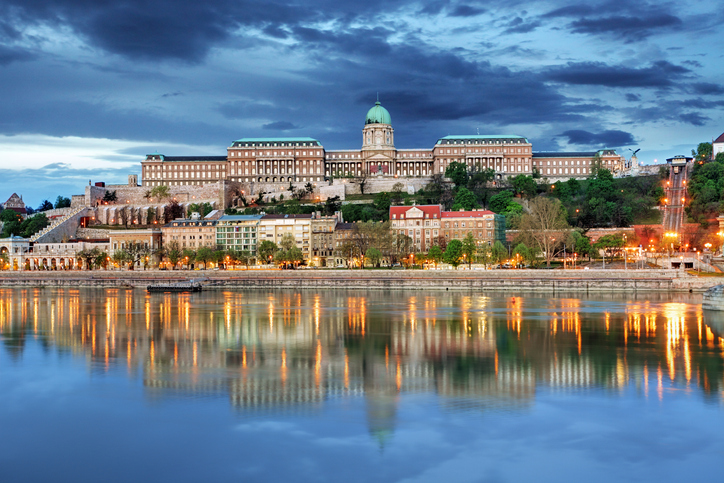Discover the best dinner spots in Budapest at the Zsidai Group restaurants, where excellent food and unforgettable experiences await in the heart of the city!
Discover the History of Buda Castle from the Middle Ages to Today!
One of Budapest’s most prominent and significant landmarks is Buda Castle, which stands majestically atop Castle Hill by the Danube. This historic site is not only a symbol of the city but also of Hungary’s history. Over the centuries, Buda Castle has undergone numerous transformations and is much more than just a complex of buildings; it is a place where the past and present intersect, with every stone and corner telling a story.
The Beginnings – The Strategic Importance of Castle Hill
Castle Hill’s prominent geographical location attracted attention even in ancient times. Its proximity to the Danube and the surrounding hills provided natural protection, making the area strategically significant. The Romans, who settled in the province of Pannonia, established their settlement called Aquincum at the foot of Castle Hill, which was the precursor to modern-day Budapest. Although the Romans did not fortify the hill itself, the settlements established here laid the groundwork for the later castle.
The predecessor of the present-day Buda Castle was built in the 13th century, after the devastation caused by the Mongol invasion highlighted the need for defense. King Béla IV recognized the strategic importance of Castle Hill and began constructing the first fortifications in 1247, which protected the royal residence and the city. The foundations of the walls and towers built at that time are still visible in the Castle District today.

The Middle Ages and the Renaissance Golden Age
During the Middle Ages, Buda Castle became the main residence of the Hungarian kings. Under the reign of Sigismund of Luxembourg in the late 14th and early 15th centuries, the castle underwent significant expansion and fortification. It was during Sigismund’s reign that the castle began to be developed into a truly impressive palace complex, which became one of Europe’s largest and most beautiful royal residences at the time.
The Renaissance period reached its peak during the reign of Matthias Corvinus. Known as the "Great King," Matthias enriched the castle with Renaissance features. He built a library and a chapel alongside the royal palace and invited numerous foreign artists and scholars to his court. Matthias's Renaissance court was famous far and wide, and Buda Castle reached its zenith during this period, both architecturally and culturally.
The Ottoman Occupation and Habsburg Rule
In 1541, Buda Castle fell into Ottoman hands, and over the next 150 years, the Ottoman conquerors made significant changes to the area. Although the royal palace was largely destroyed, the Ottomans built mosques and baths in the Castle District. During the occupation, the city of Buda lost much of its former grandeur and served primarily as a military center.
In 1686, the Habsburgs retook Buda from the Ottomans and began rebuilding the castle. During the 18th century, the Habsburg rulers reconstructed the royal palace in Baroque style, and Buda Castle once again became the political and cultural center of the country.
The Baroque palace was built on the site of the old medieval castle, incorporating remains of the former buildings into the new structure.
In the 19th century, Buda Castle underwent further significant changes. After the suppression of the War of Independence and following the Compromise of 1867, the royal palace was expanded and modernized, with neoclassical wings added to the Baroque building. By the end of the construction, Buda Castle had become an imposing architectural complex worthy of the Hungarian kings’ residence.
The Modern Era – Destruction and Reconstruction
During World War II, Buda Castle suffered severe damage. Intense fighting and bombings led to the destruction or severe damage of the royal palace and many buildings in the Castle District. After the war, under communist rule in Hungary, the reconstruction of the castle began.
In the 1950s, during the restoration of Buda Castle, the communist leadership decided not to restore the royal palace to its original Baroque and neoclassical styles but rather to give it a simplified, almost austere appearance. The former lavish interiors were destroyed, and the palace’s function changed: it now houses museums and cultural institutions.
In the late 20th and early 21st centuries, Buda Castle underwent further renovations. In the 1990s, several buildings in the Castle District were restored, and today the area has become one of Budapest’s most popular tourist destinations. The royal palace now houses the Hungarian National Gallery, the Budapest History Museum, and the National Széchényi Library, all of which offer rich cultural offerings to visitors.
Buda Castle Today – Where History and Culture Meet
Today, Buda Castle is not only a historical monument but also a center for culture, art, and gastronomy. As visitors stroll through the Castle District, they can find numerous museums, galleries, and exhibitions showcasing the richness of Hungarian history and culture.
Buda Castle – The Legacy of the Past and the Hope for the Future
The history of Buda Castle is uniquely rich and diverse, reflecting Hungary’s turbulent history. Over the centuries, the castle has been not only the home of kings and military leaders but also a symbol of the Hungarian nation. Although the buildings and walls have suffered destruction from time to time, Buda Castle has always been rebuilt and today proudly displays the glory of the past.
Exploring Buda Castle allows visitors to not only learn about a slice of history but also experience a place where the past and present harmoniously meet. The atmosphere of the Castle District, the rich offerings of museums and exhibitions, and the gastronomic experiences all contribute to making Buda Castle more than just a simple attraction—it is a living, breathing historical monument that provides a lasting experience for every visitor.

